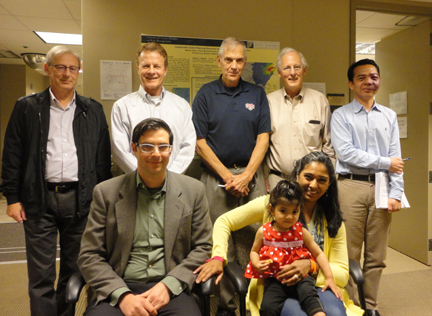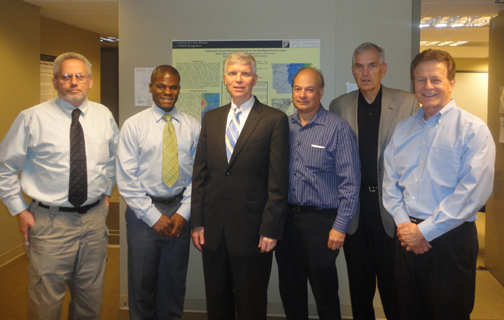On May 20, 2014, Adam Jachimowicz defended his doctoral dissertation on “Post-Disaster Interim Housing: Forecasting Requirements and Determining Key Planning Factors.”

The purpose of Adam’s research was to investigate a problem and current tools that emergency management officials commonly use when faced with the challenge of housing disaster victims. Based upon input from experts, additional tools need to be developed to provide more comprehensive and time effective strategies to address interim housing needs. The tools that this research addresses are quantitative in nature, based on systems engineering concepts, and can provide additional information to disaster responders and planners that will allow them to make better decisions. This research attempts to address several problems that have been highlighted in interviews and literature based on past disasters.
The first part of Adam’s research focused on the “Planner’s Dilemma,” which is discussed below. This problem was addressed by interviewing a group of subject matter experts (SMEs) using a structured feedback process to develop a prioritized list of key factors for consideration when conducting operational planning for a post-disaster interim housing mission.
The second part dealt specifically with the issue of forecasting post-disaster interim housing requirements and explores an overall cost of the mission by developing a mathematical model and forecast tool. This model and tool are based on a unique method that differs from existing approaches.
Serving on Adam’s Final Examining Committee were EMSE Professors Jonathan Deason, Joost Santos and Gregory Shaw, along with Dr. Steve Diaz, Deputy Director, Readiness Support Center U.S. Army Corps of Engineers and Dr. Jack Harrald, Professor Emeritus.
Ronald Meris
On May 5, 2014, By Ronald G. Meris defended his doctoral dissertation on “A Plume Model to Enhance Situation Awareness for Decision-Maker During an Outdoor Airborne HAZMAT Release.” In a large-scale outdoor airborne hazardous materials (HAZMAT) incident, such as ruptured chlorine rail cars during a train derailment, the local Incident Commanders and HAZMAT emergency responders must obtain accurate information quickly in order to assess the situation and act promptly and appropriately. HAZMAT responders must have a clear understanding of key information and must integrate it into action planning in order to generate timely and effective decisions.
Ron’s study examined the use of HAZMAT plume modeling as a decision support tool during incident action planning in this type of extreme HAZMAT incident. Scientists and engineers created software to simulate and predict HAZMAT plume behavior, the projected hazard areas, and the associated health effects. Incorporating the HAZMAT plume projection model into an Incident Action Plan may be a complex process. The concept of Situation Awareness as presented by Endsley's dynamic situation awareness model contains three levels: perception, comprehension, and projection. It is used to examine the actions of incident managers related to adequate data acquisition, current situational understanding, and accurate situation projection. The analysis employed a mixed qualitative and quantitative methodological approach to examine the use and limitations of a “HAZMAT Plume Modeling Cycle” process that can be integrated into the incident action planning cycle. HAZMAT response experts were interviewed using a computer-based simulation of a HAZMAT scenario to structure the data collection and promote realistic responses.
Serving on Ron’s Final Dissertation Examining Committee were EMSE professors Dr. Joseph A Barbera, Dr. Gregory Shaw, Dr. Jonathan P. Deason, and Dr. Royce A. Francis, along with Dr. Peter Leitner, National Intelligence University, Defense Intelligence Agency.
Jill Hottel
In the Spring 2014 semester, student Jill Brickey Hottel successful defended her Professional Degree Project on “The Roadless Rule as a Model for Land Conservation: Investigating the Utility of the Environmental Transition Hypothesis as Relates to the Adoption of the Roadless Rule in Developing Nations.”
In 2001 Congress passed Roadless Rule, a law established under the U.S. Forest Service to protect inventoried roadless areas in the United States. The purpose of the rule was to limit road construction, reconstruction, and timber harvesting in an effort to prevent the loss of roadless area values and characteristics. While this law has been met with legal battles since it was authorized, there may be value in utilizing it as a model for land conservation in developing nations. To explore how that can be accomplished, an Environmental Transition Hypothesis was developed and proposes that a nation’s economic development, demographic status, and environmental quality can determine where a nation may fall on a scale of environmental conservation. Further, the Environmental Transition Hypothesis can help define how a nation values the surrounding environment and whether a policy, such as the Roadless Rule, could be useful in land conservation efforts.


